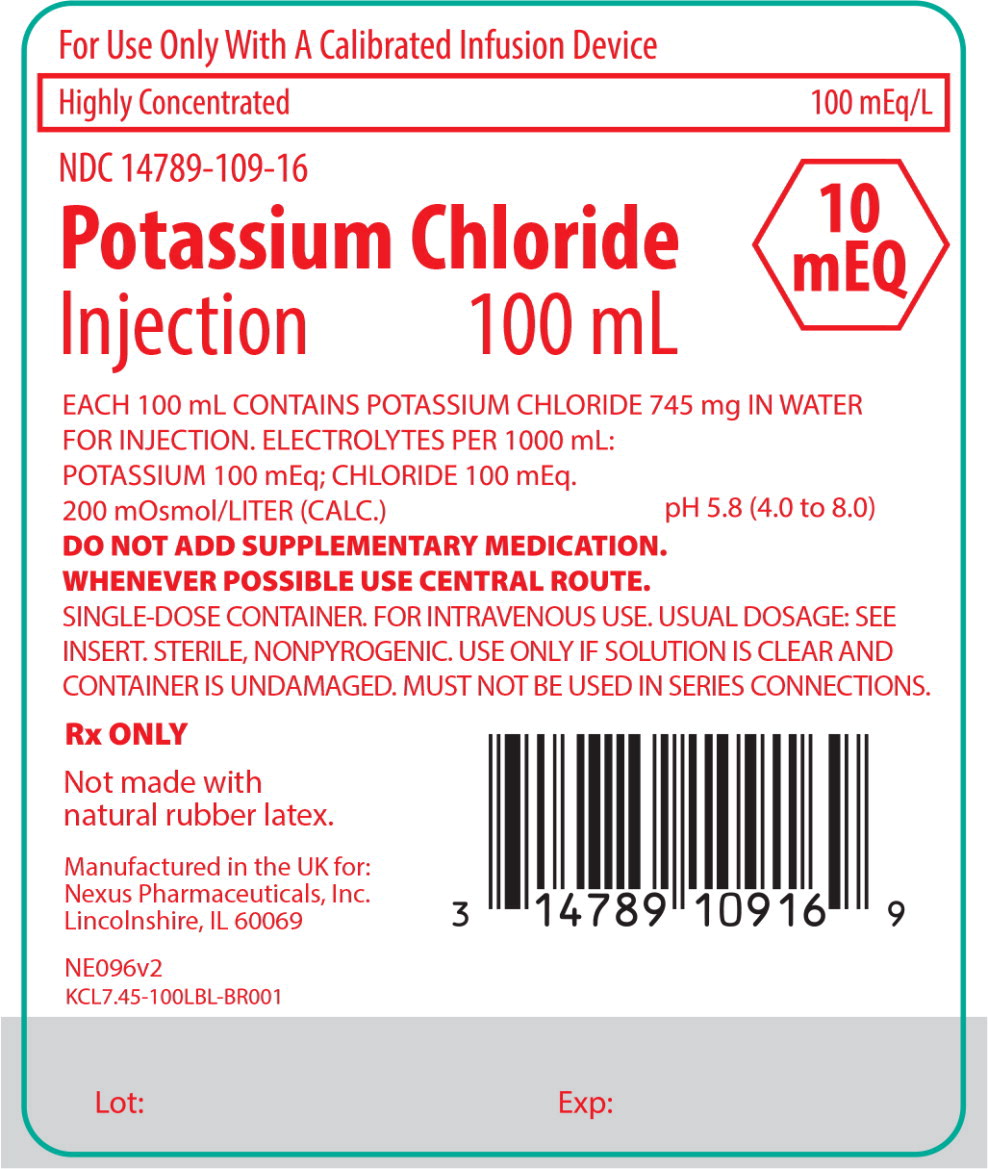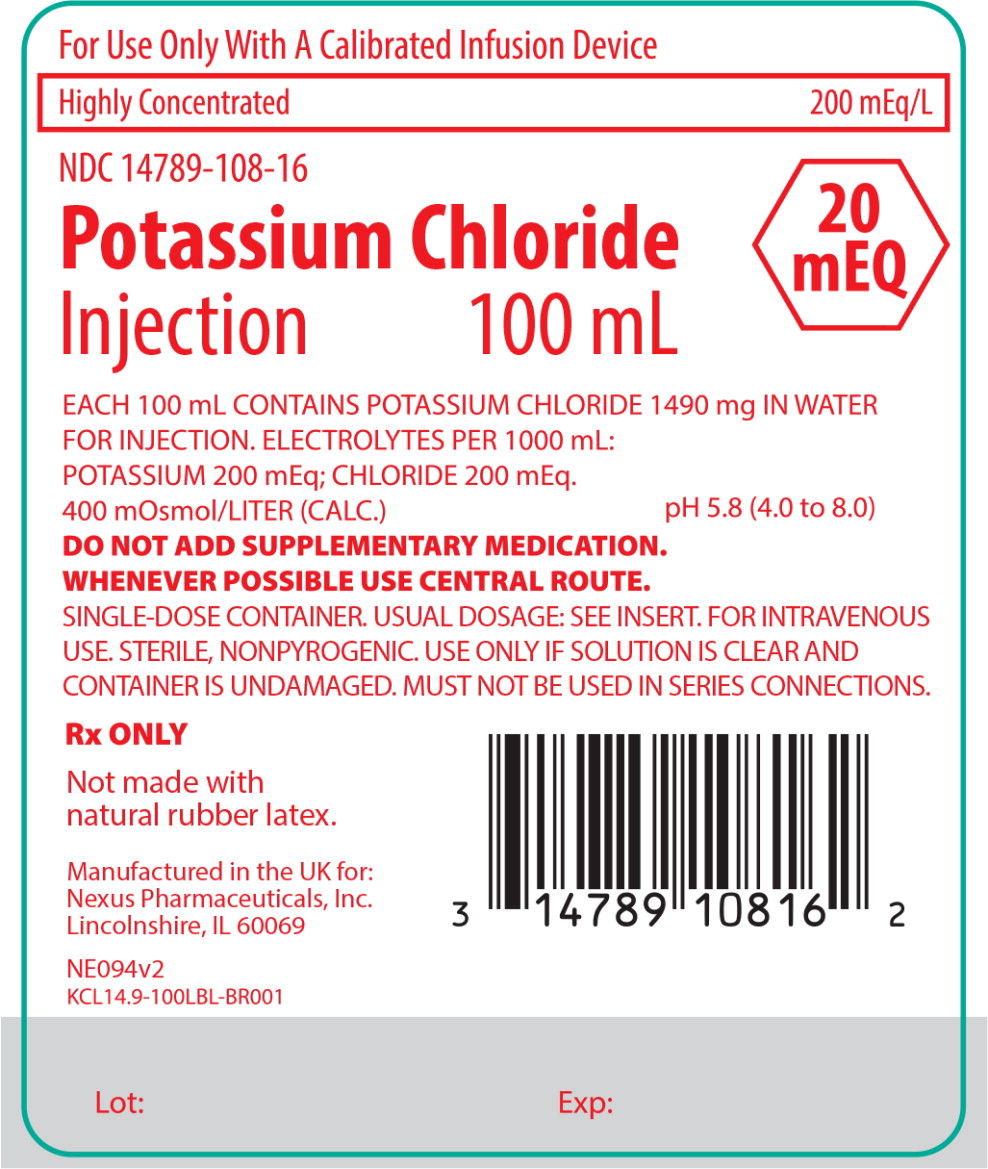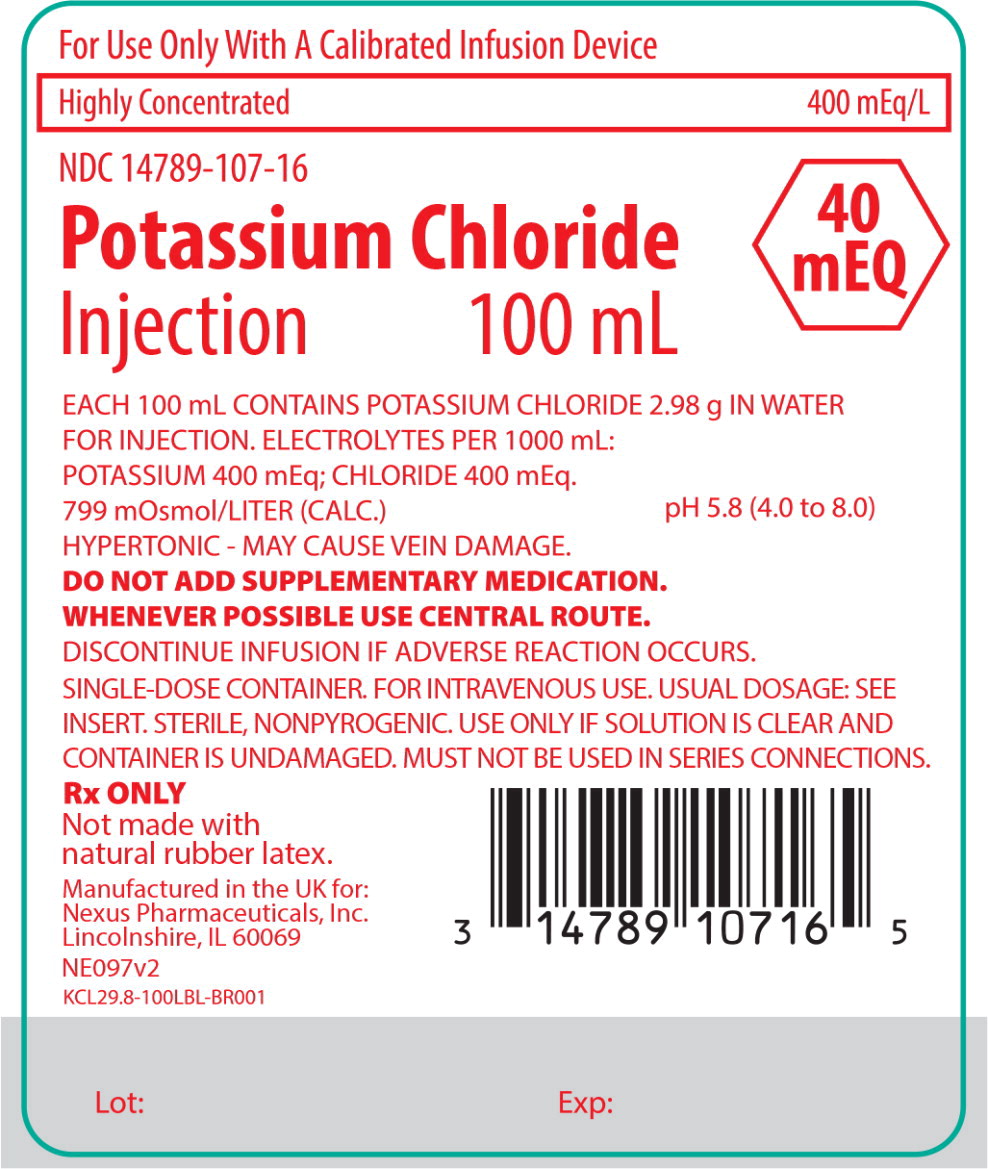For Use Only With A Calibrated Infusion Device
| Highly Concentrated |
Flexible Plastic Container Ready To Use
Rx only
DESCRIPTION
This Potassium Chloride Injection, is a sterile, nonpyrogenic, highly concentrated, readyto-use, solution of Potassium Chloride, USP in Water for Injection, USP for electrolyte replenishment in a single dose container for intravenous administration. It contains no antimicrobial agents.
|
* Normal physiologic osmolarity range is approximately 280 to 310 mOsmol/L. Administration of substantially hypertonic solutions (≥600 mOsmol/L) may cause vein damage. |
|||||
| Potassium Chloride Injection mEq Potassium/ Container | Composition
(g/L) Potassium Chloride, USP (KCl) | Osmolarity*
(mOsmol/L) (calc) | pH | Ionic Concentration (mEq/L) | |
| Potassium | Chloride | ||||
| 10 mEq/100 mL | 7.45 | 200 | 5.8 (4.0 to 8.0) | 100 | 100 |
| 10 mEq/50 mL 20 mEq/100 mL | 14.9 | 400 | 5.8 (4.0 to 8.0) | 200 | 200 |
| 20 mEq/50 mL 40 mEq/100 mL | 29.8 | 799 | 5.8 (4.0 to 8.0) | 400 | 400 |
CLINICAL PHARMACOLOGY
Potassium is the major cation of body cells (160 mEq/liter of intracellular water) and is concerned with the maintenance of body fluid composition and electrolyte balance. Potassium participates in carbohydrate utilization, protein synthesis, and is critical in the regulation of nerve conduction and muscle contraction, particularly in the heart. Chloride, the major extracellular anion, closely follows the metabolism of sodium, and changes in the acid-base of the body are reflected by changes in the chloride concentration.
Normally about 80 to 90% of the potassium intake is excreted in the urine, the remainder in the stools and to a small extent, in the perspiration. The kidney does not conserve potassium well so that during fasting, or in patients on a potassium-free diet, potassium loss from the body continues resulting in potassium depletion. A deficiency of either potassium or chloride will lead to a deficit of the other.
INDICATIONS AND USAGE
Potassium Chloride Injection is indicated in the treatment of potassium deficiency states when oral replacement is not feasible.
THIS HIGHLY CONCENTRATED, READY-TO-USE POTASSIUM CHLORIDE INJECTION IS INTENDED FOR THE MAINTENANCE OF SERUM K+ LEVELS AND FOR POTASSIUM SUPPLEMENTATION IN FLUID RESTRICTED PATIENTS WHO CANNOT ACCOMMODATE ADDITIONAL VOLUMES OF FLUID ASSOCIATED WITH POTASSIUM SOLUTIONS OF LOWER CONCENTRATION.
When using these products, these patients should be on continuous cardiac monitoring and frequent testing for serum potassium concentration and acid-base balance.
CONTRAINDICATIONS
Potassium Chloride Injection is contraindicated in patients with:
- hyperkalemia
- known hypersensitivity to Potassium Chloride Injection
WARNINGS
Hyperkalemia
THIS HIGHLY CONCENTRATED, READY-TO-USE POTASSIUM CHLORIDE INJECTION IS INTENDED FOR THE MAINTENANCE OF SERUM K+ LEVELS AND FOR POTASSIUM SUPPLEMENTATION IN FLUID RESTRICTED PATIENTS WHO CANNOT ACCOMMODATE ADDITIONAL VOLUMES OF FLUID ASSOCIATED WITH POTASSIUM SOLUTIONS OF LOWER CONCENTRATION.
TO AVOID POTASSIUM INTOXICATION, DO NOT INFUSE THESE SOLUTIONS RAPIDLY.
Potassium Chloride Injection should be administered with extreme caution, if at all, to patients with conditions predisposing to hyperkalemia and/or associated with increased sensitivity to potassium, such as patients with:
- severe renal impairment,
- acute dehydration,
- extensive tissue injury or burns,
- certain cardiac disorders such as congestive heart failure or AV block,
- potassium-aggravated skeletal muscle channelopathies (e.g., hyperkalemic periodic paralysis, paramyotonia congenita, and potassium-aggravated myotonia/ paramyotonia).
Potassium Chloride Injection should be administered with caution to patients who are at risk of experiencing hyperosmolality, acidosis, or undergo correction of alkalosis (conditions associated with a shift of potassium from intracellular to extracellular space) and patients treated concurrently or recently with agents or products that can cause hyperkalemia (see PRECAUTIONS, Drug Interactions).
If used in high-risk patients, especially close monitoring and careful dose selection and adjustment is required.
PATIENTS REQUIRING HIGHLY CONCENTRATED SOLUTIONS SHOULD BE KEPT ON CONTINUOUS CARDIAC MONITORING AND UNDERGO FREQUENT TESTING FOR SERUM POTASSIUM AND ACID-BASE BALANCE, ESPECIALLY IF THEY RECEIVE DIGITALIS.
Administration of concentrated potassium solutions can cause cardiac conduction disorders (including complete heart block) and other cardiac arrhythmias at any time during infusion. Continuous cardiac monitoring is performed to aid in the detection of cardiac arrhythmias due to a sudden increase in serum potassium concentration (e.g., when potassium infusion is started), or transient or sustained hyperkalemia (see ADVERSE REACTIONS and OVERDOSAGE).
Frequently, mild or moderate hyperkalemia is asymptomatic and may be manifested only by increased serum potassium concentrations and, possibly, characteristic EKG changes. However, fatal arrhythmias can develop at any time during hyperkalemia.
Serum potassium levels are not necessarily indicative of tissue potassium levels.
Tissue Damage and Thrombophlebitis
When infusing concentrated potassium solutions, including Potassium Chloride Injection, care must be taken to prevent paravenous administration or extravasation because such solutions may be associated with tissue damage, which may be severe and include vascular, nerve, and tendon damage, leading to surgical intervention, including amputation. Secondary complications including pulmonary embolism from thrombophlebitis have been reported as a consequence of tissue damage from potassium chloride.
Administer intravenously only with a calibrated infusion device at a slow, controlled rate. (see DOSAGE AND ADMINISTRATION). Highest concentrations (400 mEq per L) should be exclusively administered via central intravenous route. Whenever possible, administration via a central route is recommended for all concentrations of Potassium Chloride Injection for thorough dilution by the blood stream and decreasing the risk of extravasation and to avoid pain and phlebitis associated with peripheral infusion. Correct placement of the catheter should be verified before administration.
Hyponatremia
Monitoring of serum sodium is particularly important for hypotonic fluids. Potassium Chloride Injection has an osmolarity of 200 to 799 mOsmol/L (see DESCRIPTION).
Potassium Chloride Injection may cause hyponatremia. The risk for hyponatremia is increased, in pediatric patients, elderly patients, postoperative patients, those with psychogenic polydipsia and in patients treated with medications that increase the risk of hyponatremia (such as certain diuretic, antiepileptic and psychotropic medications) (see PRECAUTIONS, Drug Interactions).
Acute hyponatremia can lead to acute hyponatremic encephalopathy characterized by headache, nausea, seizures, lethargy and vomiting. Patients with brain edema are at particular risk of severe, irreversible and life-threatening brain injury.
Avoid Potassium Chloride Injection in patients with or at risk for hyponatremia. If use cannot be avoided, monitor serum sodium concentrations.
High volume infusion must be used with close monitoring in patients with cardiac or pulmonary failure, and in patients with non-osmotic vasopression release (including SIADH), due to the risk of hospital-acquired hyponatremia.
Fluid Overload
Depending on the volume and rate of infusion, and the patient's underlying clinical condition, the intravenous administration of Potassium Chloride Injection can cause electrolyte disturbances such as overhydration/hypervolemia and congested states including central (e.g., pulmonary edema) and peripheral edema.
Avoid Potassium Chloride Injection in patients with or at risk for fluid and/or solute overloading. If use cannot be avoided, monitor fluid balance, electrolyte concentrations and acid base balance as needed and especially during prolonged use.
PRECAUTIONS
General
Do not connect flexible plastic containers in series in order to avoid air embolism due to possible residual air contained in the primary container.
Laboratory Tests
Serum potassium levels are not necessarily indicative of tissue potassium levels.
Clinical evaluation and periodic laboratory determinations are necessary to monitor changes in fluid balance, electrolyte concentrations, and acid-base balance during prolonged parenteral therapy or whenever the condition of the patient warrants such evaluation. Significant deviations from normal concentrations may require the use of additional electrolyte supplements, or the use of electrolyte-free dextrose solutions to which individualized electrolyte supplements may be added.
Drug Interactions
Other Products that Cause Hyperkalemia
Administration of Potassium Chloride Injection in patients treated concurrently or recently with other products that can cause hyperkalemia or increase the risk of hyperkalemia (e.g., potassium-sparing diuretics, ACE inhibitors, angiotensin II receptor antagonists, cyclosporine and tacrolimus) increases the risk of severe and potentially fatal hyperkalemia, in particular in the presence of other risk factors for hyperkalemia (see WARNINGS). Avoid use of Potassium Chloride injection in patients receiving such products. If use cannot be avoided, monitor serum potassium concentrations.
Other Drugs that Increase the Risk of Hyponatremia
Administration of Potassium Chloride Injection in patients treated concomitantly with drugs associated with hyponatremia may increase the risk of developing hyponatremia (see WARNINGS). Avoid use of Potassium Chloride Injection in patients receiving drugs that may increase the risk of hyponatremia, such as diuretics and antiepileptics. Drugs that increase the vasopressin effect reduce renal electrolyte free water excretion and may also increase the risk of hyponatremia following treatment with intravenous fluids.
If use cannot be avoided, monitor serum sodium concentrations.
Pregnancy:
There are no adequate, well controlled studies with Potassium Chloride Injection in pregnant women and animal reproduction studies have not been conducted with this drug. Therefore, it is not known whether potassium chloride injection can cause fetal harm when administered to a pregnant woman. Potassium Chloride Injection should be given during pregnancy only if potential benefit justifies the potential risk to the fetus.
ADVERSE REACTIONS
The following adverse reactions associated with the use of Potassium Chloride Injection were identified in postmarketing reports. Because these reactions were reported voluntarily from a population of uncertain size, it is not always possible to estimate their frequency, reliably, or to establish a causal relationship to drug exposure.
Immune system disorders: Hypersensitivity, as manifested by rash and angioedema
Metabolism and nutrition disorders: Hyperkalemia, hyponatremia
Cardiac disorders: Cardiac arrest*, asystole*, ventricular fibrillation*, bradycardia
*as a manifestation of rapid intravenous administration and/or of hyperkalemia
Respiratory, Thoracic, and Mediastinal Disorders: Dyspnea
General disorders and administration site conditions: Chest pain, infusion site thrombosis, infusion site phlebitis, infusion site erythema, infusion site swelling, infusion site pain, infusion site irritation, and/or a burning sensation.
Nervous System Disorders: Hyponatremic encephalopathy
The following adverse reactions were reported in association with extravasation: Skin necrosis, skin ulcer, soft tissue necrosis, muscle necrosis, nerve injury, tendon injury, and vascular injury.
OVERDOSAGE
Potassium overdose can cause potentially fatal hyperkalemia. Manifestations of hyperkalemia include:
- Disturbances in cardiac conduction and arrhythmias, including bradycardia, heart block, asystole, ventricular tachycardia, ventricular fibrillation
- Hypotension
- Muscle weakness up to and including muscular and respiratory paralysis, paresthesia
- Gastrointestinal symptoms (ileus, nausea, vomiting, abdominal pain)
Frequently, mild or moderate hyperkalemia is asymptomatic and may be manifested only by increased serum potassium concentrations and, possibly, characteristic electrocardiographic changes. However, fatal arrhythmias can develop at any time.
In addition to arrhythmias and conduction disorders, the EKG shows progressive changes that occur with increasing potassium levels. Possible changes include:
- peaking of T waves,
- loss of P waves, and
- QRS widening.
However, the correlation between potassium levels and EKG changes is not precise, and whether or at which potassium level certain EKG signs develop depends on factors such as patient sensitivity, the presence of other electrolyte disorders, and the rapidity of the development of hyperkalemia.
The presence of any EKG findings that are suspected to be caused by hyperkalemia should be considered a medical emergency.
In the event of hyperkalemia, discontinue the infusion immediately and institute close EKG, laboratory and other monitoring and, as necessary, corrective therapy to reduce serum potassium levels as necessary. The use of potassium containing foods or medications must also be eliminated.
Treatment of mild to severe hyperkalemia with signs and symptoms of potassium intoxication includes the following:
- Dextrose Injection, USP, 10% or 25%, containing 10 units of crystalline insulin per 20 grams of dextrose administered intravenously, 300 to 500 mL per hour.
- Absorption and exchange of potassium using sodium or ammonium cycle cation exchange resin, orally and as retention enema.
- Hemodialysis and peritoneal dialysis.
In cases of digitalization, too rapid a lowering of plasma potassium concentration can cause digitalis toxicity.
DOSAGE AND ADMINISTRATION
The dose and rate of administration are dependent upon the specific condition of each patient.
Administer intravenously only with a calibrated infusion device at a slow, controlled rate. Highest concentrations (400 mEq/L) should be exclusively administered via central intravenous route. Whenever possible, administration via a central route is recommended for all concentrations of Potassium Chloride Injection for thorough dilution by the blood stream and decreasing the risk of extravasation and to avoid pain and phlebitis associated with peripheral infusion (see WARNINGS). Correct placement of the catheter should be verified before administration.
Recommended administration rates should not usually exceed 10 mEq per hour or 200 mEq for a 24 hour period if the serum potassium level is greater than 2.5 mEq per liter.
In urgent cases where the serum potassium level is less than 2.0 mEq per liter or where severe hypokalemia is a threat, (serum potassium level less than 2.0 mEq per liter and electrocardiographic changes and/or muscle paralysis), rates up to 40 mEq per hour or 400 mEq over a 24 hour period can be administered very carefully when guided by continuous monitoring of the EKG and frequent serum K+ determinations to avoid hyperkalemia and cardiac arrest.
Parenteral drug products should be inspected visually for particulate matter and discoloration, whenever solution and container permit. Do not administer unless solution is clear and seal is intact. Use of a final filter is recommended during administration of all parenteral solutions where possible.
Do not add supplementary medication.
Preparation for Administration (Use aseptic technique)
- Close flow control clamp of administration set.
- Remove cover from outlet port at bottom of container.
- Insert piercing pin of administration set into port with a twisting motion until the set is firmly seated.
NOTE: See full directions on administration set carton. - Suspend container from hanger.
- Squeeze and release drip chamber to establish proper fluid level in chamber.
- Open flow control clamp and clear air from set. Close clamp.
- Attach set to venipuncture device. If device is not indwelling, prime and make venipuncture.
- Regulate rate of administration with flow control clamp.
WARNING: Do not use flexible container in series connections. Do not add supplementary medication. Such use could result in air embolism due to residual air being drawn from the primary container before administration of the fluid from the secondary container is completed.
HOW SUPPLIED
Potassium Chloride Injection in flexible plastic containers is available as follows:
| NDC for each individual IV Bag | Potassium per container |
| 14789-109-16 | 10 mEq/100 mL |
| 14789-108-08 | 10 mEq/50 mL |
| 14789-108-16 | 20 mEq/100 mL |
| 14789-107-08 | 20 mEq/50 mL |
| 14789-107-16 | 40 mEq/100 mL |
Exposure of pharmaceutical products to heat should be minimized. Avoid excessive heat.
Store at 20 to 25°C (68 to 77°F). [See USP Controlled Room Temperature.]
Manufactured in the UK
Manufactured for Nexus Pharmaceuticals, Inc.,
Lincolnshire, IL 60069 USA
KCLPI01GBR02
Revised: 03/2023
NEXUS
PHARMACEUTICALS
Principal Display Panel - 50 mL (400 mEq/L) Bag Label
For Use Only With A Calibrated Infusion Device
Highly Concentrated
400 mEq/L
NDC 14789-107-08
Potassium Chloride
Injection
50 mL
20 mEQ
EACH 50 mL CONTAINS POTASSIUM CHLORIDE 1.49 g IN WATER
FOR INJECTION. ELECTROLYTES PER 1000 mL:
POTASSIUM 400 mEq; CHLORIDE 400 mEq.
799 mOsmol/LITER (CALC.)
pH 5.8 (4.0 to 8.0)
HYPERTONIC - MAY CAUSE VEIN DAMAGE.
DO NOT ADD SUPPLEMENTARY MEDICATION.
WHENEVER POSSIBLE USE CENTRAL ROUTE.
DISCONTINUE INFUSION IF ADVERSE REACTION OCCURS.
SINGLE-DOSE CONTAINER. FOR INTRAVENOUS USE. USUAL DOSAGE: SEE
INSERT. STERILE, NONPYROGENIC. USE ONLY IF SOLUTION IS CLEAR AND
CONTAINER IS UNDAMAGED. MUST NOT BE USED IN SERIES CONNECTIONS.
Rx ONLY
Not made with
natural rubber latex.
Principal Display Panel - 50 mL (200 mEq/L) Bag Label
For Use Only With A Calibrated Infusion Device
Highly Concentrated
200 mEq/L
NDC 14789-108-08
Potassium Chloride
Injection
50 mL
10 mEQ
EACH 100 mL CONTAINS POTASSIUM CHLORIDE 1490 mg IN WATER
FOR INJECTION. ELECTROLYTES PER 1000 mL:
POTASSIUM 200 mEq; CHLORIDE 200 mEq.
400 mOsmol/LITER (CALC.)
pH 5.8 (4.0 to 8.0)
DO NOT ADD SUPPLEMENTARY MEDICATION.
WHENEVER POSSIBLE USE CENTRAL ROUTE.
SINGLE-DOSE CONTAINER. USUAL DOSAGE: SEE INSERT. FOR INTRAVENOUS
USE. STERILE, NONPYROGENIC. USE ONLY IF SOLUTION IS CLEAR AND
CONTAINER IS UNDAMAGED. MUST NOT BE USED IN SERIES CONNECTIONS.
Rx ONLY
Not made with
natural rubber latex.
Principal Display Panel - 100 mL (100 mEq/L) Bag Label
For Use Only With A Calibrated Infusion Device
Highly Concentrated
100 mEq/L
NDC 14789-109-16
Potassium Chloride
Injection
100 mL
10 mEQ
EACH 100 mL CONTAINS POTASSIUM CHLORIDE 745 mg IN WATER
FOR INJECTION. ELECTROLYTES PER 1000 mL:
POTASSIUM 100 mEq; CHLORIDE 100 mEq.
200 mOsmol/LITER (CALC.)
pH 5.8 (4.0 to 8.0)
DO NOT ADD SUPPLEMENTARY MEDICATION.
WHENEVER POSSIBLE USE CENTRAL ROUTE.
SINGLE-DOSE CONTAINER. FOR INTRAVENOUS USE. USUAL DOSAGE: SEE
INSERT. STERILE, NONPYROGENIC. USE ONLY IF SOLUTION IS CLEAR AND
CONTAINER IS UNDAMAGED. MUST NOT BE USED IN SERIES CONNECTIONS.
Rx ONLY
Not made with
natural rubber latex.
Principal Display Panel - 100 mL (200 mEq/L) Bag Label
For Use Only With A Calibrated Infusion Device
Highly Concentrated
200 mEq/L
NDC 14789-108-16
Potassium Chloride
Injection
100 mL
20 mEQ
EACH 100 mL CONTAINS POTASSIUM CHLORIDE 1490 mg IN WATER
FOR INJECTION. ELECTROLYTES PER 1000 mL:
POTASSIUM 200 mEq; CHLORIDE 200 mEq.
400 mOsmol/LITER (CALC.)
pH 5.8 (4.0 to 8.0)
DO NOT ADD SUPPLEMENTARY MEDICATION.
WHENEVER POSSIBLE USE CENTRAL ROUTE.
SINGLE-DOSE CONTAINER. USUAL DOSAGE: SEE INSERT. FOR INTRAVENOUS
USE. STERILE, NONPYROGENIC. USE ONLY IF SOLUTION IS CLEAR AND
CONTAINER IS UNDAMAGED. MUST NOT BE USED IN SERIES CONNECTIONS.
Rx ONLY
Not made with
natural rubber latex.
Principal Display Panel - 100 mL (400 mEq/L) Bag Label
For Use Only With A Calibrated Infusion Device
Highly Concentrated
400 mEq/L
NDC 14789-107-16
Potassium Chloride
Injection
100 mL
40 mEQ
EACH 100 mL CONTAINS POTASSIUM CHLORIDE 2.98 g IN WATER
FOR INJECTION. ELECTROLYTES PER 1000 mL:
POTASSIUM 400 mEq; CHLORIDE 400 mEq.
799 mOsmol/LITER (CALC.)
pH 5.8 (4.0 to 8.0)
HYPERTONIC - MAY CAUSE VEIN DAMAGE.
DO NOT ADD SUPPLEMENTARY MEDICATION.
WHENEVER POSSIBLE USE CENTRAL ROUTE.
DISCONTINUE INFUSION IF ADVERSE REACTION OCCURS.
SINGLE-DOSE CONTAINER. FOR INTRAVENOUS USE. USUAL DOSAGE: SEE
INSERT. STERILE, NONPYROGENIC. USE ONLY IF SOLUTION IS CLEAR AND
CONTAINER IS UNDAMAGED. MUST NOT BE USED IN SERIES CONNECTIONS.
Rx ONLY
Not made with
natural rubber latex.




